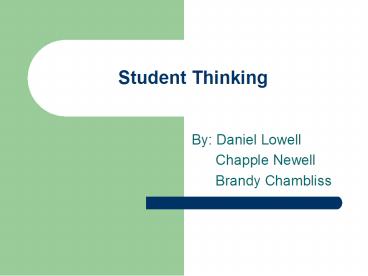Student Thinking - PowerPoint PPT Presentation
1 / 11
Title:
Student Thinking
Description:
Student Thinking. By: Daniel Lowell. Chapple Newell. Brandy Chambliss. Subitizing (Clements) ... Partitioning: Ability to separate a whole into smaller parts. ... – PowerPoint PPT presentation
Number of Views:153
Avg rating:3.0/5.0
Title: Student Thinking
1
Student Thinking
- By Daniel Lowell
- Chapple Newell
- Brandy Chambliss
2
Subitizing (Clements)
- Measurement focused on the whole.
- Counting focused on the unit
- Subitizing focused on the whole and the unit
- Perceptual Subitizing
- - Recognition (thats a three)
- - Conceptual (advanced organizer)
- eight can be organized into two
groups of four.
3
Partitioning and Grouping
- Partitioning Ability to separate a whole into
smaller parts. - Grouping Ability to combine smaller parts into
a whole. - - Students Break down smaller units of five.
- Advanced organization of larger
units. - Examples from the videos are.
4
Examples of Partitioning and Grouping
- Video- Monkeys in Two Trees
- Teacher draws a line and separates a whole, 5,
into several ways of making 5. - The children thought of many ways to divide the 5
monkeys into two trees. - One child said that to check to see if you had
all the possible answers, just cross out the 4 1
and 14, and then you would know there were no
more. - Some students decided if there were fewer
monkeys, there would be fewer possibilities.
5
More Examples of Partitioning and Grouping
- Video- Single Ten Frame
- Teacher had an arrangement of 10 boxes, some
filled with pumpkins, some empty. - Some students saw the boxes in groups of twos,
others in groups of threes. - One child said she knew what 4 looked like, so
then there were only two more. - One child saw a group of 3 on the top and a group
of three on the bottom.
6
Conceptual Subitizing
- All of these thoughts the students were thinking
reinforced the concept of - Conceptual Subitzing- The learned ability to
recognize a set of objects without have to count
them by ones.
7
Patterns
- Patterns are the ability of students to think and
organize whole into parts that they are
comfortable with. - Types Organized and Random, students able to
recognize efficient pattern. - Action Students able to transfer the organizing
of patterns. - Manipulatives tiles, fingers, dots, etc
8
Examples of Patterning
- Video- Dot Flash
- 5 dots flashed in an organized pattern for the
students to see. - One child said she saw 2 on top, 1 in the middle,
and 2 on bottom. - One child said he saw 4 and then 1 in the
middle. - The students came up with a variety of ways to
group the dots that made the pattern easier to
recognize.
9
More Examples of Patterning
- Cont. from Dot Flash
- The teacher then flashed a random pattern of
dots. - The students agreed it was harder to recognize a
scattered or random pattern than an organized or
easy pattern.
10
Examples of Patterning
- Video- Finger Patterns
- Teacher played a game with fingers and holding up
numbers on their fingers. - Some of the ideas were focused to have students
learn doubles. 2 fingers on one hand, 2 fingers
on another, how many all together? - Video- Tiles (making patterns)
- Students used manipulatives to create a pattern.
Most of the students made their patterns easy,
such as grouping 3 on the top and 3 on the
bottom, or side by side. - Some students realized that if they scattered
their pattern it would be harder for their peers
to recognize.
11
Conclusion
- Subitizing is naturally present in everyone and
is a strategy that can be built upon. - Partitioning and grouping strategies are used to
organize numbers into larger than one
thinking. - Patterns are the ability of students to think and
organize whole into parts that they are
comfortable with.































